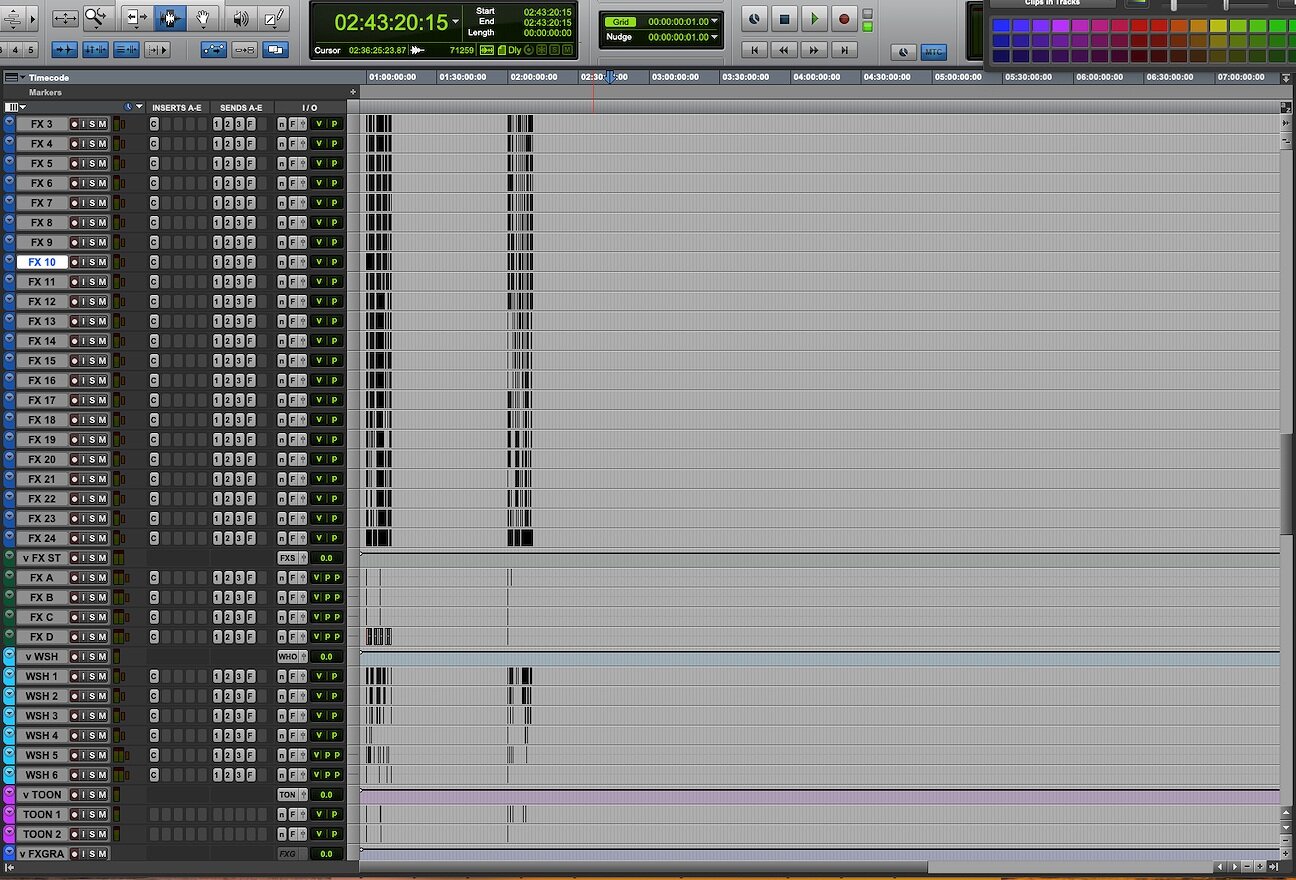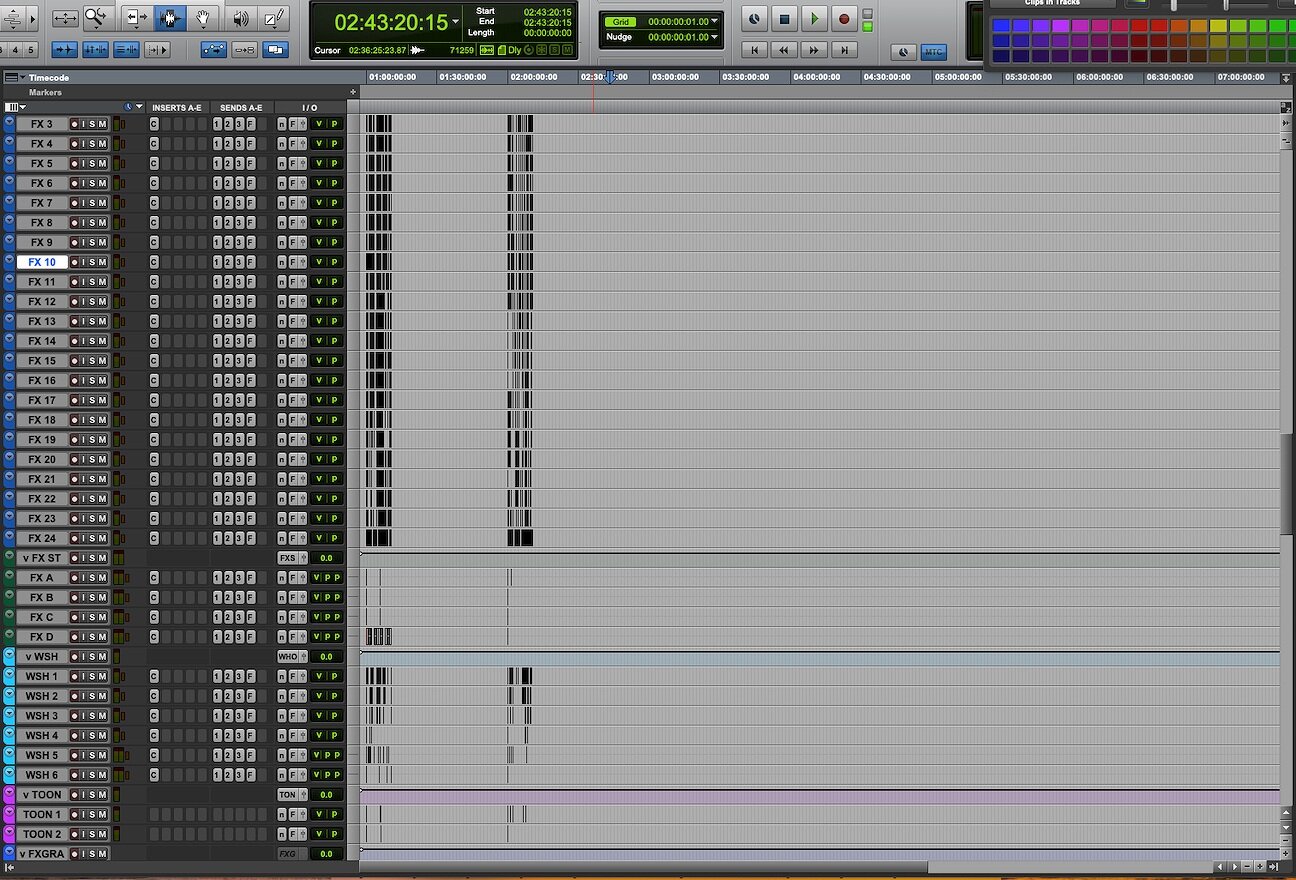DIALOGUE
When we mix an episode of animated TV, we always start with the dialogue. I usually start by setting reverbs for each scene, then mix the dialogue line by line to get it in spec and sounding natural throughout the show. Any panning, extra processing or additional reverb is also added at this time. The dialogue serves as the anchor for the rest of the mix, so it’s very important to get this locked in before adding any other elements!
MUSIC
Next, we add in the music and ride the levels throughout the show. I’ll dip it for dialogue when necessary and boost it to help keep the momentum and add excitement.
BACKGROUNDS/AMBIENCES
Then, I’ll mute the music again and mix the backgrounds and ambiences. By mixing these without the music we ensure the scene will sound natural when the music isn’t playing. Then I turn the music back on and foley is next, meaning footsteps, hand pats and movement tracks. Like music and backgrounds, the levels will vary show to show and client to client depending on preference. I’ll set an overall level and ride faders when needed throughout the show, adding panning when necessary.
SOUND EFFECTS
Lastly, I bring in the rest of the hard sound effects. These are organized into food groups such as mono effects, stereo effects, whooshes, toon, etc (shown in the photo below). Again, how these are mixed varies show to show. This is an oversimplification of the process, but this is the basic sequence I follow. I usually wrap up with a few watch downs in 5.1 and stereo to make adjustments and take one last look at mix notes from the client.

What do you look for in a good mix?
It is important that the mix supports the style of the show. Something with a lot of action should feel exciting and have a dynamic mix. An educational preschool show needs a mix that will help direct the viewer’s focus correctly and highlight the information being presented. I also think a good mix supports the story and doesn’t distract the audience. It is important that the sound is helping support the narrative and storytelling style.
Do you have any technical/creative prerequisites you think would be helpful for a mixer?
You definitely need to be an expert in Pro Tools. Understanding all of the ins and outs of writing automation through all the various parameters is essential. A strong basis as an editor is a good start here, but it helps to push into the mixing workflow and familiarize yourself with things like preview mode, latch prime in stop, surround panning, VCAs, grouping and plug-in automation. The best way to learn about these is get your hands dirty. Read the manual or some tutorials and start mixing. You will quickly learn where you can speed things up and the benefits of the different automation modes.
Creatively, the best thing you can do to prepare is to watch a pro work and learn how they approach each mix. I learned all of my mixing skills and techniques from watching Boom Box Owners Kate and Jeff mix and adopting their methods. Once I understood what they were doing and why I worked to get faster and developed my own techniques and style!
Referencing other shows and films is also a great way to get ideas and help your mixing improve. Critically listening to a mix on TV or in a theater can really surprise you, and I would recommend paying close attention to how the music and sound effects levels change throughout a film.
What do you wish you would’ve known before becoming a mixer?
Probably that it’s OK to not be able to hear EVERYTHING all of the time. It took me a while to really understand this, and it’s definitely fundamental. It’s important that the mix doesn’t sound cluttered through the whole show with an abundance of unnecessary sound. Editors cut for complete coverage, but as a mixer, it is your entire job to decide what sounds or music are most important for the audience to hear at each moment, and not overwhelm them with sounds that don’t support the story the filmmaker is telling in a scene.
Also Latch Prime in Stop, which lets you write automation without playing back. When I first started mixing I probably wasted a lot of time writing panning and volume automation in real-time that could have easily been done in a half a second when stopped.
What would you say the hardest obstacle is when it comes to mixing?
As I mentioned in the previous answer, the hardest obstacle is determining where to direct the viewer’s attention and how best to accomplish that. It can be extra challenging when you consider how much time, effort and creativity went into each sonic piece. The sound effects editor may have spent all day creating an amazing glowing steady for the magic orb in the background, but if the characters are having an important story conversation, it is not the time to feature those sound effects. You may really love the cello melody in this particular scene, but you know the audience needs to notice the distant explosions that draw the character’s attention off-screen. You make hundreds of these types of decisions during a mix and learning which direction to take things can really make or break the final product.
Hopefully, Jacob’s insight gives you a better understanding of mixing! If you enjoyed this post, you should also check out Jeff’s mixing post about the technical side of mixing:
DEMYSTIFYING THE TECHNICAL SIDE OF MIXING
WRITTEN BY JACOB COOK – RE-RECORDING MIXER, BOOM BOX POST
